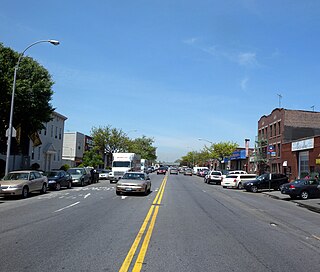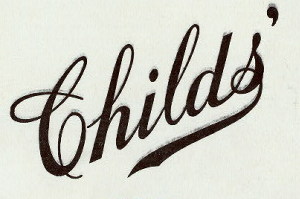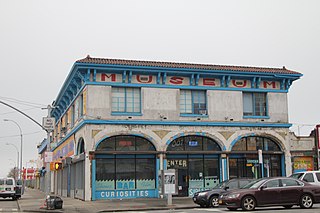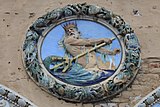
An amusement park is a park that features various attractions, such as rides and games, as well as other events for entertainment purposes. A theme park is a type of amusement park that bases its structures and attractions around a central theme, often featuring multiple areas with different themes. Unlike temporary and mobile funfairs and carnivals, amusement parks are stationary and built for long-lasting operation. They are more elaborate than city parks and playgrounds, usually providing attractions that cater to a variety of age groups. While amusement parks often contain themed areas, theme parks place a heavier focus with more intricately-designed themes that revolve around a particular subject or group of subjects.

Coney Island is a peninsular neighborhood and entertainment area in the southwestern section of the New York City borough of Brooklyn. The neighborhood is bounded by Brighton Beach to its east, Lower New York Bay to the south and west, and Gravesend to the north, and includes the subsections of Sea Gate to its west and Brighton Beach to its east. Coney Island was formerly the westernmost of the Outer Barrier islands on the southern shore of Long Island, but in the early 20th century it became a peninsula, connected to the rest of Long Island by land fill.
The Half Moon Hotel in Coney Island, Brooklyn, New York, was a 225-foot-tall, 14-story hotel that opened on May 5, 1927, on the Riegelmann Boardwalk at West 29th Street. The Half Moon was built to help Coney Island compete with the beach resort Atlantic City, New Jersey. The hotel was designed by the architectural firm of George B. Post and Sons and built by the Cauldwell-Wingate Co.

Steeplechase Park was an amusement park in Coney Island, Brooklyn, New York City. Steeplechase Park was created by entrepreneur George C. Tilyou in 1897 and operated until 1964. It was the first of the three original iconic large parks built on Coney Island, the other two being Luna Park (1903) and Dreamland (1904). Of the three parks, Steeplechase was the longest-lasting, running for 67 years.

Edward J. Riegelmann was an American Democratic politician from Brooklyn, Kings County, New York, best remembered for the Riegelmann Boardwalk.

The Parachute Jump is a defunct amusement ride and a landmark on the Riegelmann Boardwalk on Coney Island in Brooklyn, New York. It consists of a 250-foot-tall (76 m), 170-short-ton (150 t) open-frame, steel parachute tower. It has twelve cantilever steel arms radiating from the top of the tower; when it was in operation, these each supported a parachute attached to a lift rope and a set of guide cables. Riders were belted into a two-person canvas seat, lifted to the top, and dropped; the parachute and shock absorbers at the bottom would slow their descent.

Stillwell Avenue is a major two-way north/south thoroughfare in southern Brooklyn and the central section of Coney Island. It is 2.4 miles (3.9 km) long and begins at a dead end at Riegelmann Boardwalk on Coney Island. The road goes north, leaving Coney Island, ending at Bay Parkway, where the road continues as the Bay Ridge Parkway. On December 11, 2008 it acquired the subsidiary name Polar Bear Club Walk, named for the Coney Island Polar Bear Club. The Stillwell Avenue/Surf Avenue intersection on Coney Island is the location of the Coney Island–Stillwell Avenue subway station, a major subway station in New York City.

Frederic Charles Hirons was the American architect, based in New York City, who designed the Classical George Rogers Clark National Memorial, in Vincennes, Indiana, among the last major Beaux-Arts style public works in the United States, completed in 1933.

The Riegelmann Boardwalk is a 2.7-mile-long (4.3 km) boardwalk along the southern shore of the Coney Island peninsula in New York City, adjacent to the Atlantic Ocean. Opened in 1923, the boardwalk runs between West 37th Street at the edge of the Sea Gate neighborhood to the west and Brighton 15th Street in Brighton Beach to the east. It is operated by the New York City Department of Parks and Recreation.

Childs Restaurants was one of the first national dining chains in the United States and Canada, having peaked in the 1920s and 1930s with about 125 locations in dozens of markets, serving over 50,000,000 meals a year, with over $37 million in assets at the time. Childs was a pioneer in a number of areas, including design, service, sanitation, and labor relations. It was a contemporary of food service companies such as Horn & Hardart, and a predecessor of companies such as McDonald's.

The South Beach–Franklin Delano Roosevelt Boardwalk, alternately referred to as the FDR Boardwalk or the South Beach Boardwalk, is a boardwalk facing the Lower New York Bay on the East Shore of Staten Island, one of the five boroughs of New York City. The boardwalk is the main feature of a public park that stretches from Fort Wadsworth and the Verrazzano-Narrows Bridge to Miller Field, both part of the Gateway National Recreation Area. The park also contains numerous recreational facilities, including a skate park.

Luna Park is the name of an amusement park in Coney Island, Brooklyn, New York City. It opened on May 29, 2010, at the site of Astroland, an amusement park that had been in operation from 1962 to 2008, and Dreamland, which operated at the site in 2009. It was named after the original 1903 Luna Park which existed until 1944 on a site just north of the current park's 1000 Surf Avenue location.

Deno's Wonder Wheel Amusement Park is a family-owned amusement park located at Coney Island, Brooklyn, New York City. It features five adult rides and 16 kiddie rides, including a dozen family rides that parents and children can ride together. The park is named for its main attraction, the Wonder Wheel, a 150-foot (46 m) eccentric wheel built in 1920.

Shoot the Freak was an attraction on the Riegelmann Boardwalk at Coney Island, Brooklyn, New York that operated from 2000 until its demolition in 2010. The game was located on West Boardwalk in Coney Island. The game was considered one of the distinctive attractions of Coney Island. A successor, called Shoot the Clown, opened in a different location on the Boardwalk in 2013.

The Childs Restaurant Building on Surf Avenue is a New York City designated landmark on Surf Avenue at West 12th Street in Coney Island, Brooklyn. It was completed in 1917 for Childs Restaurants, an early restaurant chain and one of the largest in the United States at that time. Its design, by John Westervelt, Childs' in-house architect, shows "elements of the Spanish Revival style." The company built a much larger Childs location on the Coney Island Boardwalk in 1923, but continued to operate the Surf Avenue location until 1943.

The Ford Amphitheater at Coney Island is an outdoor live entertainment venue within the Childs Restaurants building on the Riegelmann Boardwalk in Coney Island, Brooklyn, New York City. The venue opened in June 2016.

The B&B Carousell is a historic carousel at Coney Island in Brooklyn, New York City. It was built by Coney Island-based manufacturer William F. Mangels c. 1906–1909, with wooden horses carved by Marcus Illions. The carousel has been relocated and refurbished several times over its history. The B&B Carousell has been located in Luna Park since 2013.

The Shore Theater, is a former theater in Coney Island, Brooklyn, New York City. The seven-story neo-Renaissance Revival building, with office space as well as a theater, is located at the intersection of Surf and Stillwell Avenues, across from Nathan's Famous and the Coney Island–Stillwell Avenue station. Completed in 1925, it was one of several structures that was intended to boost the development of Coney Island as a year-round entertainment destination. After being abandoned in the 1970s, it stood unused for several years before being developed into a hotel in the late 2010s; however, as of 2020, the building is still undergoing construction.



























